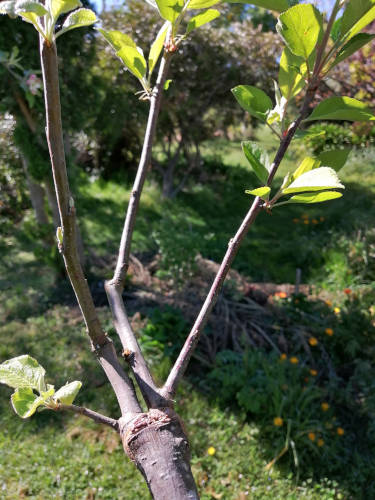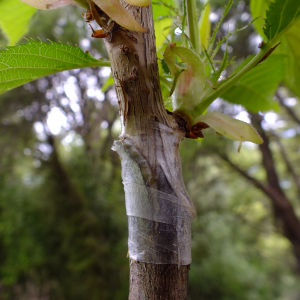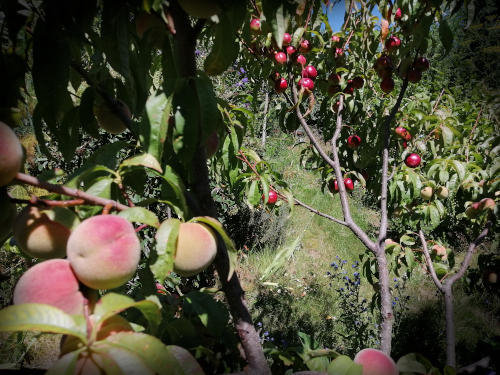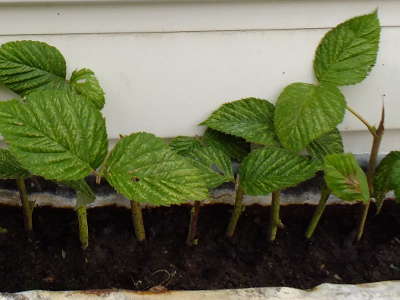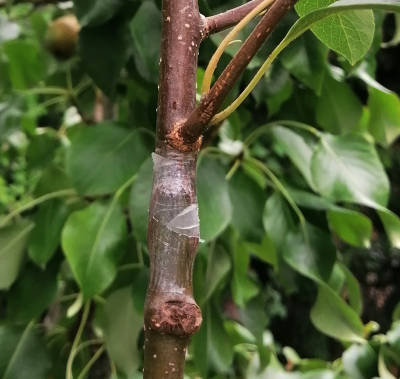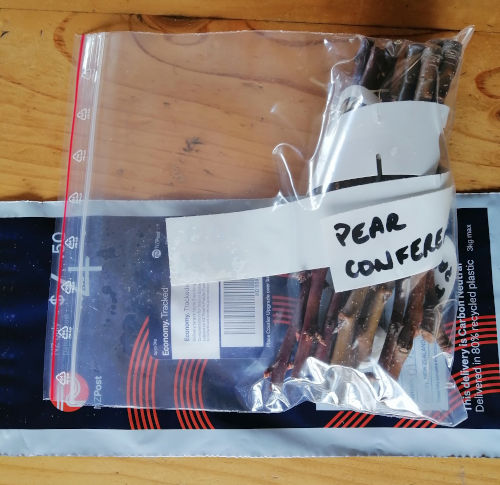The Art and Practice of Grafting Fruit Trees
Grafting is the practice of combing the desirable characteristics of multiple compatible plant species to produce super or hyper natural trees.
It removes the uncertainty, randomness and adaptation that comes with genetically unique trees grown from seed.
Whichever method of grafting you use, remember these important points:
- The cambium layers of the stock and scion must be in contact with each other.
- Make smooth cuts to provide close contact.
- Work as rapidly as possible to prevent drying of the cut surfaces.
- Bind or wax the cut area to prevent drying of the tissue. I use a tape product called Buddy Tape which is perforated into easy to tear of lengths (like toilet paper) while being stretchy and tacky.
- Bindings should not be so tight or left on so long that they impair or stop the expansion growth of the stem. Buddy tape often disintegrates after 12 - 18 months.
- Use only properly identified and properly stored scion wood with healthy buds.
- Do the job at the proper time - Grafting is done in winter or early spring with dormant scion wood.
- Use sharp tools.
Graft types / techniques
Although grafting is still used, budding is becoming the method of choice in fruit tree production. Budding requires: (1) less proficiency in handling a knife, thus making it easier; (2) much less time, making it more economical; and (3) a much smaller scion resource. However, a major disadvantage is that budding is mostly limited to active growth periods of the year when labour demands may be high for other growing operations.
The Whip Graft
 The whip graft (also known as the tongue graft) is particularly useful for species that unite easily, such as the apple and pear (Figure 4). It may be used in making a root, stem, or top graft as long as the stock and scion are near the same size. Scions and stocks from the size of a pencil to 12mm in diameter are the best to use.
The whip graft (also known as the tongue graft) is particularly useful for species that unite easily, such as the apple and pear (Figure 4). It may be used in making a root, stem, or top graft as long as the stock and scion are near the same size. Scions and stocks from the size of a pencil to 12mm in diameter are the best to use.
Stem or Top Grafting with the Whip Graft
Whip grafting to dwarf rootstocks follows the same procedure except the scion is placed uniformly 15 to 20 mm above the roots. This allows the dwarf tree to be set deeper in the soil at first planting for added support, and keeps the scion 50 - 75 mm above the soil line. The new plant needs to be set high because if the scion takes root, the dwarfing character of the rootstock will be lost.
Timing is important when whip grafting in the field on the stem or branches. The danger of cold injury should be past, but the graft must be made before the bark of the stock begins to slip. Usually stem grafting is done when the buds on the original stock begin to swell in the spring. The scion is then dormant. Keep all buds below the graft removed. Spurs may be left on to provide the needed leaf surface until the shoots from the scion have a sufficient number of leaves to do the job.

Bark Graft
The bark graft is often used when the stock is too large for whip grafting. This graft is used mainly on pears, apples, and nuts such as pecans and walnuts. Dormant scion wood is used, but the stock is not ready until the bark begins to slip. Prepare the stock by cutting squarely across the trunk or branch with a fine-toothed saw at a point that is from 25 to 50 mm in diameter.
Prepare two scions 12 to 15 mm long by making a sloping cut 5 mm above the top bud and a 50 mm long diagonal cut on the lower end (Figure 6). Place the cut surface of the scion against the side of the stock. When viewed from the opposite side, 3 mm of the cut surface should be showing above the top of the stock. Hold firmly in place, and with the point of the knife, outline the scion on the bark. Finish cutting through the bark. Remove this bark and insert the scion. Use 12 to 20 mm wire nails to hold the scion in place. Place the other scion on the opposite side. These operations should be done as rapidly as possible to limit drying of the cut surfaces.
After care of the graft is important. Keep shoots and sprouts below the graft removed. If both of the scions live, pinch back the shoot of the weaker one several times during the summer. Both scions should continue to grow the second summer. Gradually reduce the development of the weaker one by pruning, and in the spring of the next year, remove it completely. During the first or second summer, the strong scion may need to be topped to encourage branching.
Cleft-Graft
The cleft-graft is one of the older grafting methods. Good technique can make it one of the most successful. It is mainly suited for top working apple and pear trees. The process simply involves fitting a scion into a split stock. The best time to perform the cleft-graft is just before the bark begins to slip in the spring.
When preparing the stock for the cleft-graft, l ook for:
ook for:
- scaffold limbs or trunks from 1 - 50mm in diameter,
- areas on limbs that have straight grain for at least 6 inches below the amputation point (this area should also be free from spurs, knots, and cankers), and
- limbs that grow more toward the vertical than horizontal position. Grafts on horizontal limbs will likely 'take' just as well, but the resulting sharp-angled upright growth is very undesirable.
After locating the point of amputation, make the cut with a fine-toothed saw. Take care to prevent the limb from splitting or the bark from peeling. Using a cleft-graft knife and a wooden mallet, split the stock across the center and to a depth of about 150 mm. After the scions are prepared, the split is held apart by driving the wedge of the cleft knife into the center of the split.
For the hobbyist, a small hatchet may be substituted and the split held open with a small cold chisel or large screwdriver.
Prepare two dormant scions by making a sloping cut on each side of the scion. The slopes on the scion and split should closely coincide. The cut on the scion should start slightly below the bottom bud. There is no need to bring the cuts to a point; a length of 50 mm is sufficient. The inside of the wedge should be slightly thinner than the outside.
When joining the stock and the scion, remember that the bark of the stock will be thicker than the bark of the scion, so be sure to place the cambia in contact with each other. The top of the cut surface of the scion should be flush with the top of the stock, and it is most important that the cambium layers touch at this point. If the scion is loose in the stock, wrap the split with waxed cloth for three months. To prevent constricting the limb, cut the cloth after three months, but do not remove it. Seal all cut surfaces.
Important Points - Whichever method of grafting you use, remember these important points:
- The cambium layers of the stock and scion must be in contact with each other.
- Make smooth cuts to provide close contact.
- Work as rapidly as possible to prevent drying of the cut surfaces.
- Bind or wax the cut area to prevent drying of the tissue.
- Bindings should not be so tight or left on so long that they impair or stop the expansion growth of the stem.
- Use only properly identified and properly stored scion wood with healthy buds.
- Do the job at the proper time - Grafting is done in winter or early spring with dormant scion wood.
- Use sharp tools.
